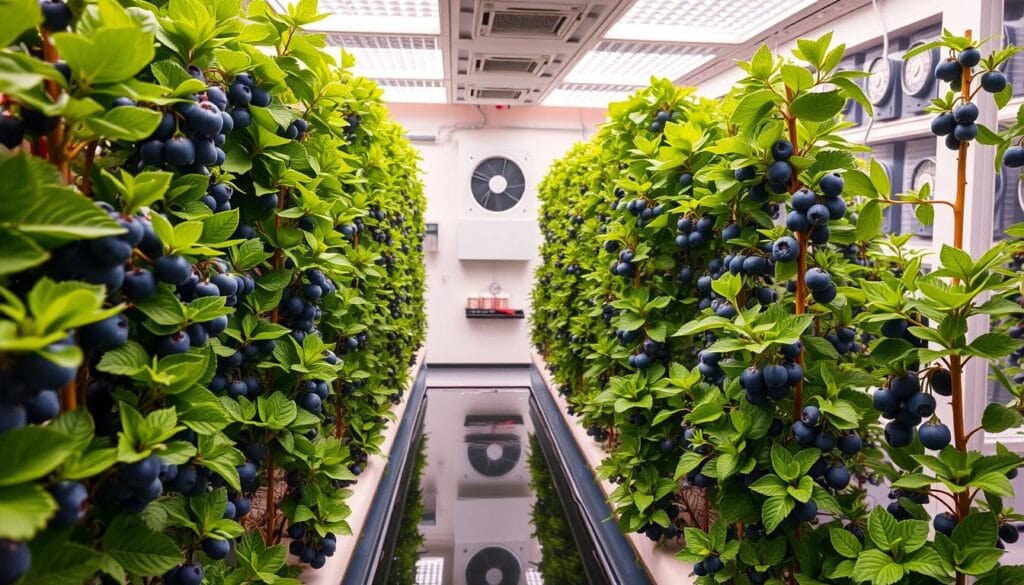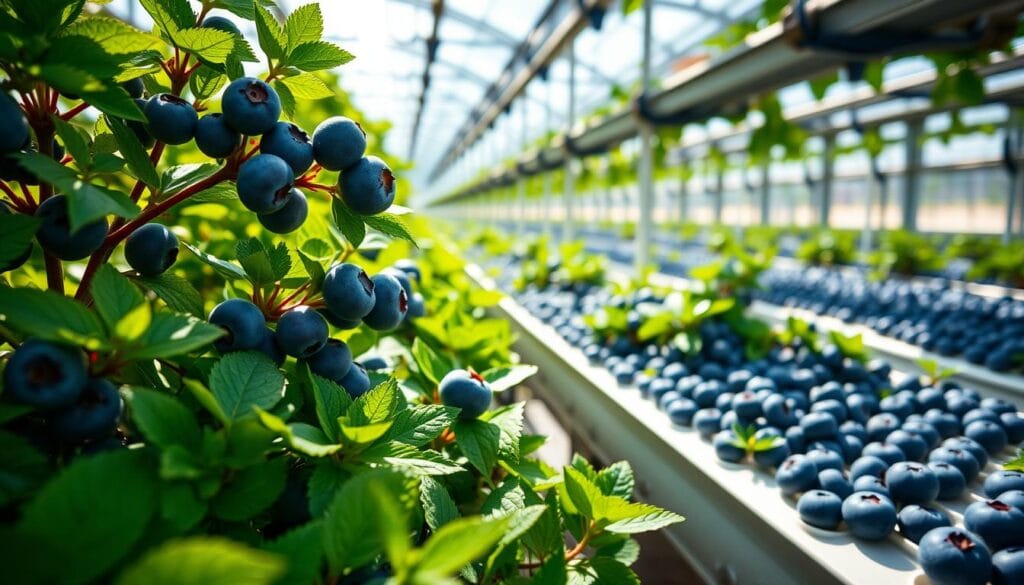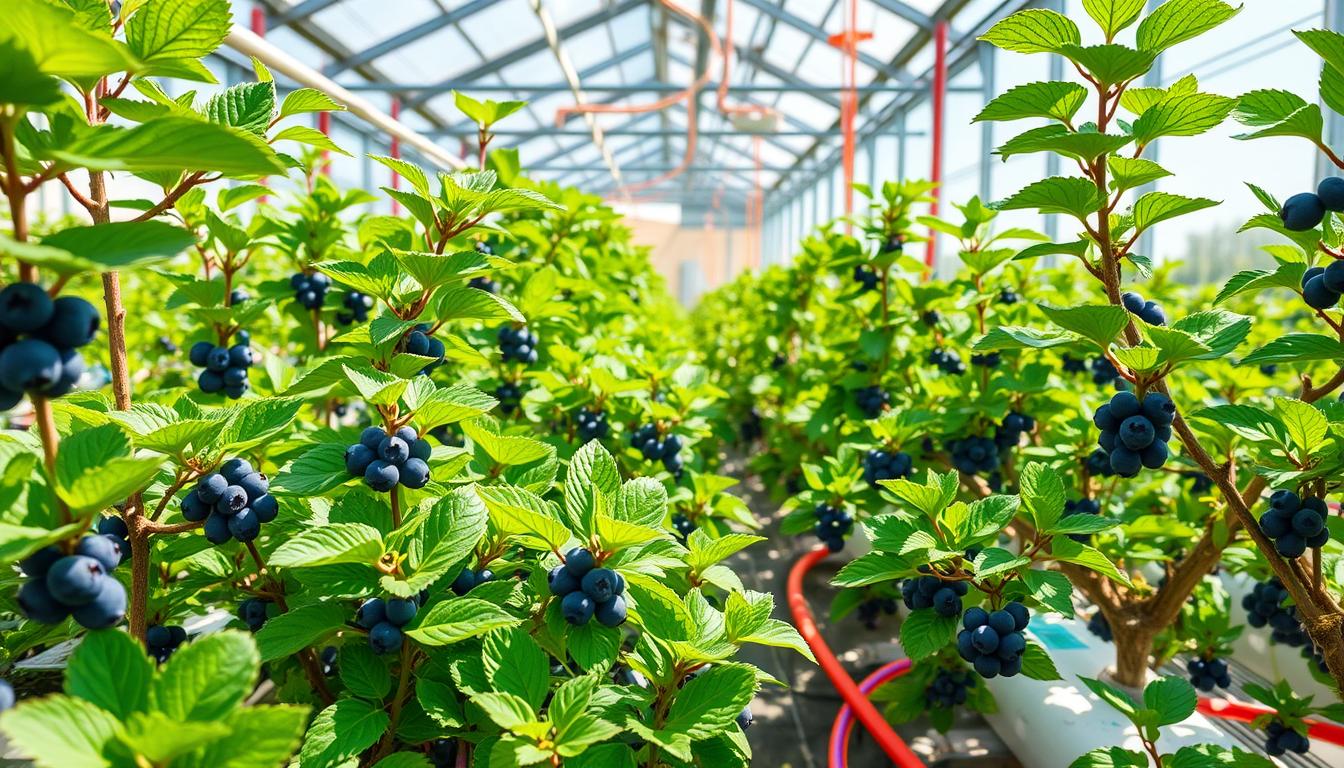I’ve always loved gardening and wanted to grow blueberries in hydroponics. But the idea of dealing with soil, pH, and climate seemed too hard. That changed when I found hydroponic gardening. It lets me control the growing space and give the right nutrients to my plants.
In this guide, I’ll share 7 key secrets for growing great hydroponic blueberries. These tips will help you, whether you’re new to hydroponics or have experience. They’ll help you get the most out of your blueberry plants.
Key Takeaways:
- Hydroponics offers a controlled environment for optimal blueberry growth and higher yields
- Proper nutrient management and pH balance are crucial for successful hydroponic blueberry cultivation
- Selecting the right blueberry cultivars and understanding their growth characteristics are essential for hydroponic success
- Careful monitoring of temperature, light, and humidity levels can significantly impact the health and productivity of hydroponic blueberry plants
- Implementing effective pruning and training techniques can enhance the structure and yield of hydroponic blueberry plants
Understanding Hydroponic Blueberry Cultivation
Exploring hydroponic blueberry growing opens a world of possibilities. Hydroponic systems use water-soluble nutrients instead of soil. This makes them a great choice for growing blueberries.
Basics of Hydroponic Growing Systems
Hydroponic blueberry cultivation relies on special growing systems. These systems give nutrients directly to the roots. They range from simple wick systems to complex recirculating systems.
Each system aims to provide the right nutrients to blueberry plants. This is key for their growth.
Benefits of Growing Blueberries Hydroponically
Hydroponic blueberry growing has many benefits. It can increase fruit yield by up to 30% compared to soil-based cultivation. It also uses less water and space.
This makes it perfect for urban areas and places with little land. It also reduces the need for harmful chemicals by fighting pests and diseases.
Key Requirements for Success
Success in hydroponic blueberry cultivation depends on several factors. Proper nutrients, pH balance, and regular monitoring are crucial. Blueberries need a pH between 4.0 and 5.5 and a specific nutrient mix.
Keeping the environment right, like temperature and light, is also important. This ensures the plants grow well and produce more.
By understanding hydroponic blueberry cultivation, growers can reach its full potential. This innovative method can greatly improve berry production.
Essential Equipment and Setup for Hydroponic Blueberries
Starting your hydroponic blueberry journey needs careful planning and the right tools. We’ll look at the key parts and setup tips for growing blueberries in a hydroponic system.
The reservoir is at the center of your hydroponic blueberry setup. It holds the nutrient solution. Choose a durable, non-reactive material for it. This is because you’ll need to change the water often.
The growing containers are where your blueberry plants will grow. They should be big enough for the roots and for the plants to grow well.
Wicks are important for getting the nutrient solution to the roots. They’re made of materials like cotton or synthetic fibers. This guarantees that plants receive the essential nutrients they require.
Choosing the right growing medium is also key. Blueberries like a well-draining, slightly acidic soil. Coco coir, perlite, or a mix of these work well.
- Reservoir: Durable, non-reactive material to hold the nutrient solution
- Growing Containers: Appropriate size to support blueberry plant roots
- Wicks: Absorbent materials like cotton or synthetic fibers for nutrient delivery
- Growing Medium: Well-draining, slightly acidic substrates like coco coir or perlite
After getting all the parts, it’s time to set up your system. Make sure the reservoir is at the right height. Also, place the growing containers securely to avoid leaks.
With the right equipment and setup, you’re ready to enjoy the tasty harvests of hydroponic blueberries.
Selecting the Right Blueberry Varieties for Hydroponics
Selecting the right blueberry varieties is crucial for hydroponic success. Not all blueberries do well in controlled environments. To succeed with your hydroponic blueberry growing guide, pick cultivars known for hydroponics.
Best Performing Cultivars
Some top blueberry varieties for hydroponics include:
- Top Hat
- Sunshine Blue
- Draper
- Duke
- Bluecrop
Size and Growth Characteristics
Look for compact, dwarf varieties for hydroponics. They fit well in indoor setups. Bushy, well-branched plants also do great in controlled spaces.
Climate Adaptability Factors
Blueberries need specific climates. Choose varieties that match your system’s conditions. This ensures they grow and produce well.
| Blueberry Variety | Size and Growth Characteristics | Climate Adaptability |
|---|---|---|
| Top Hat | Compact, dwarf habit | Adaptable to a wide range of climates |
| Sunshine Blue | Bushy, well-branched growth | Tolerant of higher temperatures and humidity |
| Draper | Medium-sized, upright growth | Performs well in controlled environments |
| Duke | Vigorous, high-yielding | Adaptable to a variety of climate conditions |
| Bluecrop | Large, spreading habit | Prefers cooler, temperate climates |
By choosing the right blueberry varieties, you can ensure success with your hydroponic blueberry growing guide. This will lead to a fruitful harvest in your blueberry hydroponics system.
How to Grow Blueberries in Hydroponics: Step-by-Step Guide
Growing blueberries in hydroponics is rewarding and efficient. Follow a step-by-step guide to ensure success in your hydroponic blueberry garden. This guide is for both new and experienced growers. It will help you grow blueberries in hydroponics and enjoy the benefits of this method.
Preparing Your Hydroponic System
First, choose the right hydroponic system for blueberries. Deep water culture or nutrient film technique setups are best. Make sure the system is clean and sterilized before adding your plants.
Planting and Maintaining Blueberry Plants
- Choose blueberry varieties that grow well in hydroponics, like ‘Bluecrop’ or ‘Brigitta’.
- Plant seedlings or cuttings in the system, spacing them 30 to 60 centimeters apart.
- It’s important to check the nutrient and pH levels of the solution regularly. Adjust as needed to keep it between 1.8 to 2.5 EC and 4.5 to 6.0 pH.
- Watch for signs of stress or disease in the plants. Act quickly if you see any issues.
Pruning and Training Blueberry Plants
Proper pruning and training are key for your plants’ growth. Prune during the dormant season to remove dead or damaged canes. Shape the plant for better air and light.
Use a trellis or support system to guide the plant’s growth. By following these steps, you’ll be on your way to a successful grow of blueberries in hydroponics harvest. The key is to keep the right balance of nutrients, pH, and environment.
| Hydroponic Blueberry Growing Statistics | Value |
|---|---|
| Yield Increase Compared to Soil | Up to 30% |
| Faster Maturation Time | Up to 25% |
| Water Consumption Reduction | Up to 90% |
| Ideal Electrical Conductivity (EC) Range | 1.5 to 2.5 mS/cm |
| Ideal pH Range | 4.5 to 6.0 |
Optimal Nutrient Solutions and pH Levels
Keeping the right nutrient balance and pH levels is key for growing blueberries in hydroponics. Blueberries need specific nutrients and the right pH to absorb them well.
Essential Macronutrients
Blueberry plants require the right balance of nitrogen (N), phosphorus (P), and potassium (K). The best N-P-K ratio for them is between 1:1:1 and 1:2:1. Managing these nutrients well is important for the plant’s health and fruit production.
Critical Micronutrients
Blueberries also need micronutrients like iron, zinc, and boron. These help with chlorophyll, root growth, and fighting diseases. Getting the micronutrients right is crucial for blueberry growth and yield.
pH Management Techniques
Blueberries do best in acidic conditions, with a pH between 4.5 and 5.8. Keeping this pH helps them absorb nutrients. Growers can use pH up or down solutions, or even vinegar or baking soda to adjust. Regularly check and adjust the pH to maintain optimal conditions.
| Nutrient | Ideal Range |
|---|---|
| Nitrogen (N) | 50-100 ppm |
| Phosphorus (P) | 30-60 ppm |
| Potassium (K) | 50-100 ppm |
| Iron (Fe) | 2-5 ppm |
| Zinc (Zn) | 0.5-1.0 ppm |
| Boron (B) | 0.2-0.5 ppm |
| pH | 4.5-5.8 |
By managing nutrients and pH levels well, hydroponic blueberry growers can create the best environment for their plants. This leads to healthy, productive, and high-quality blueberry harvests.
Temperature and Light Requirements
Growing hydroponic blueberries needs careful control over temperature and light. To make your blueberry hydroponics system thrive, you must keep the perfect growing environment.
Blueberries do best in temperatures between 60-75°F (15-24°C) during the day. At night, they prefer 55-65°F (13-18°C). This temperature range helps them grow well, just like in nature. Keeping the temperature right is key for good fruit production and quality.
Blueberries also need lots of light, about 12-16 hours a day. If sunlight is not enough, use high-quality LED grow lights. The right light helps plants photosynthesize and grow well.
Keep an eye on temperature and light in your hydroponic blueberry growing guide. By managing these factors well, you can make your blueberry plants thrive. This will lead to a big harvest.
“Blueberries thrive in temperatures ranging from 65-75°F (18-24°C) during the day and 55-65°F (13-18°C) at night. They also require a relative humidity of 60-80% for optimal growth.”

The secret to great blueberry hydroponics is finding the perfect balance of temperature and light. By giving your plants the best conditions, you can make them reach their full potential. This way, you’ll get a big harvest.
Pruning and Training Hydroponic Blueberry Plants
Pruning and training your hydroponic blueberry plants properly are essential for their health and productivity. Knowing the right timing, methods, and maintenance is crucial. This way, you can get the most out of your blueberry harvest.
Timing of Pruning
The best time to prune your hydroponic blueberry plants is during their dormant period. This typically occurs in late winter or early spring, before the new growth begins. Pruning at this time helps the plant focus on growing strong, healthy canes and foliage.
Training Techniques
- Trellising: Use a trellis or wire support system to guide your blueberry plants’ growth. This keeps the canes upright, improving airflow and light penetration.
- Staking: Provide individual plant support with stakes. This allows the canes to grow vertically, reducing the risk of sprawling or lodging.
Maintenance Tips
- Remove dead, damaged, or diseased canes to keep the plant healthy and prevent disease spread.
- Prune back canes that are overcrowded or competing for resources. This ensures proper air circulation and light exposure.
- Shape the plants by selectively removing and thinning canes. This creates an open, balanced canopy structure.
By following these pruning and training best practices, your hydroponic blueberry plants will thrive. They will produce an abundant, high-quality harvest year after year.
Managing Common Pests and Diseases
Keeping your hydroponic blueberries healthy means watching for pests and diseases closely. It’s key to check your plants often to catch problems early. Common pests like aphids, spider mites, and whiteflies can harm your plants if not stopped.
Aphids are small, about 1/8 inch, and often found on new growth. Whiteflies, a millimeter long, hide on leaves and stems. Spider mites, almost invisible, can quickly spread.
- Use organic pest control methods whenever you can.
- Keep the right humidity and air flow to avoid fungal diseases like powdery mildew, downy mildew, and gray mold (Botrytis).
- Quarantine new plants before adding them to your system to stop pests and diseases from spreading.
Root rot is another big problem, showing as yellow leaves, droopy plants, and brown, slimy roots. It’s usually from too much water and not enough oxygen. Use the right nutrients and water to avoid root rot and keep your blueberries healthy.
By being careful, using good pest and disease control, and giving your plants the right care, you can beat the challenges of blueberry hydroponic pest control. This way, you’ll have a successful hydroponic blueberry growing guide.
Harvesting and Post-Harvest Handling
Harvesting your hydroponic blueberries at the right time is key for their quality and shelf life. Look for a deep blue color and a slight softness when you gently squeeze them. Don’t pick berries that are too ripe or too green, as they won’t taste or feel as good.
Ripeness Indicators
- Deep blue color
- Slight give when gently squeezed
- Sweet, tangy flavor
Proper Harvesting Methods
Be gentle when picking your blueberries to avoid bruising them. Use a two-finger picking method and don’t pull or twist. Place the picked blueberries in clean, shallow containers to keep them fresh.
Storage Guidelines
Keep your blueberries cool and dry after picking to make them last longer. Store them at a temperature of 40-50°F and a humidity of 50-70%. This helps prevent mold and keeps your blueberry hydroponics yield fresh. Good hydroponic blueberry cultivation and handling can make your blueberries taste better for longer.

“Harvesting blueberries at the right time and handling them with care is crucial for maintaining their quality and maximizing their shelf life.”
Maximizing Yield in Hydroponic Blueberry Production
Growing blueberries hydroponically can greatly increase your yield. By adjusting nutrient solutions and keeping the right growing conditions, you can reach your hydroponic blueberry operation’s full potential. Proper plant care is also crucial.
Using different growing media, like coconut coir, is a smart strategy. Farmers globally are turning to coir for blueberry growth because it boosts yields and fruit quality. Coir is cheaper and lets you grow more plants per hectare than soil farming.
Controlling the growing environment is vital for better blueberry yields in hydroponics. Managing pH, electrical conductivity, and nutrients is essential for growth and fruit quality. Hydroponics also saves water and reduces disease risks compared to soil farming.
Following best practices like pruning, training, and pest management can also improve yields. Research shows hydroponic blueberry farming can yield 30% more than traditional soil farming.
To get the most out of your hydroponics, keep up with new research and techniques. Trying different cultivars and methods can help you find the best approach for your setup. Hydroponics can unlock new levels of blueberry yield and quality.
Troubleshooting Common Growing Issues
Growing hydroponic blueberries is rewarding but comes with challenges. Starting your blueberry hydroponics system means being ready for common problems. Quick action and adjustments can keep your plants healthy and productive.
Keeping the right pH is key for blueberries. They need a pH between 4.5 and 6.0. Test your solution’s pH often and adjust it with pH up or down solutions.
Nutrient imbalances can also affect your plants. Use a nutrient solution made for fruiting plants. Check the solution’s electrical conductivity (EC) to ensure it’s between 1.5 to 2.5 mS/cm.
Space is important too. Blueberries need 30 to 60 centimeters between each plant. This lets them grow well without competing.
Pests and diseases can be a problem. Look for aphids, spider mites, and root rot often. Use biological controls and chemicals wisely if needed.
Non-flowering or non-fruiting plants might need more light, better temperature, or nutrient solution. Yellow leaves could mean water, nutrient, pH, or root problems. Fix these issues to help your plants.
Remember, growing hydroponic blueberries takes time. Harvesting may take anywhere from a few months to a year. Stay patient, keep up with your plants, and you’ll get a great yield.
| Common Growing Issue | Potential Causes | Troubleshooting Strategies |
|---|---|---|
| pH Imbalance | – Improper nutrient solution pH – Water source pH issues – Growing medium composition | – Test and adjust pH using pH up/down solutions – Monitor and stabilize nutrient solution pH |
| Nutrient Deficiencies | – Insufficient nutrient levels – Nutrient lockout due to pH issues – Imbalanced nutrient ratios | – Provide a comprehensive hydroponic nutrient solution – Adjust pH to optimal range – Monitor and correct nutrient imbalances |
| Pests and Diseases | – Aphids, spider mites, and other pests – Root rot and other fungal diseases | – Implement integrated pest management strategies – Use biological controls and selective chemical treatments |
| Non-flowering/Fruiting | – Inadequate light exposure – Suboptimal temperature conditions – Nutrient imbalances | – Adjust light intensity and duration – Maintain proper temperature ranges – Ensure balanced nutrient solution |
| Yellowing Leaves | – Water-related issues – Nutrient deficiencies – pH imbalances – Root problems | – Check water quality and irrigation patterns – Correct nutrient deficiencies – Adjust pH to optimal range – Inspect and address root issues |
By tackling these common issues early, you’ll have a successful hydroponic blueberry growing guide. Your blueberry hydroponics system will thrive, giving you a great harvest.
“By carefully monitoring and making timely adjustments, you can overcome the challenges of hydroponic blueberry growing and enjoy a healthy, productive garden.”
Conclusion
Hydroponic blueberry farming has many benefits. It can lead to higher yields and better control over the growing environment. By managing nutrients, pH levels, temperature, and light, you can grow delicious blueberries.
Hydroponics also helps reduce pests and diseases. This makes your blueberry crop more consistent and reliable.
While it needs careful attention and learning, the rewards are worth it. With the right techniques and a commitment to improve, you can make your hydroponic blueberry farming successful. Staying updated with new methods can also boost your yields and blueberry quality.
The key to success in blueberries in hydroponics is adapting to its unique needs. By refining your practices, you can unlock the full potential of this rewarding and profitable venture.

